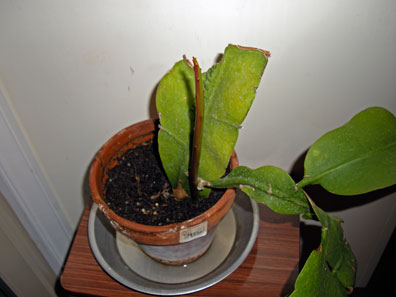Growth and decay
By growth, I'm referring to the new cereus, purchased last year to replace the old plant that died about a year ago now. After a rough start, the plant is growing quickly, producing the stalk seen in the photo below. The leaf seen at rear is disfigured, the result of a rotting disease that luckily appears to have been arrested. Getting the plant more natural light appears to have been the cure.

By decay, I'm referring to Scientific American which has in its March issue a story on electronic markets that contains a remarkable claim:
[T]he futures market for orange juice concentrate predicts Florida weather better than the National Weather Service.
This statement is offered without proof, without reference or citation, and without even defining what it means by "weather" or revealing what its metrics for success or skill are. I found several sloppy or needlessly contentious statements among the articles in that issue, which I bought and perused in an airport while awaiting a flight. I used to read Scientific American years ago. I don't know why I stopped reading it, but I know why I won't be resuming that old habit anytime soon.
And I'd still like to see the proof.
Labels: cereus, Scientific American, sloppy reporting



5 Comments:
It might interest you to know (or not?) that the "leaves" are specialized stems, flattened, as it were, to function in like manner. It is after all a cactus, having adapted itself to non-terrestrial environs such as the crooks of trees in tropical rainforests. This is also why it's happier in tight containers (smaller pots) not to mention its tendency to send out those long, gawky-looking stalks which eventually flatten and branch (looking for light). It's flowering mechanism is also an environment specialization (exhausting its meager nutrients, it endeavors to produce and spread seed), putting all of it's energy into florescence. Hence, as you've discovered, over-feeding merely throws it out of whack! The flower's white coloration, scent, and even it's shape are specific to attracting night-flying moths for pollenation. As to the "rotting" you describe, this is not usually a disease, but brought on by over watering (killing with kindness). ...
I have had my cereus plant for 3 years now. It's in a 15" pot in full sun (Los Angeles). It has bloomed twice, the last being this April (14 blooms). The blooms open during the day and stay open for about 3 days but there is no smell. Any thoughts on whether it's a different plant or what I can do to entice the aroma out of it? I have pics but don't know how to enclose them. It looks like all the pics I've seen of the night blooming cereus.
Hi, Tracy. My educated guess is there is not. To begin with, these plants aren't really "cereus" (an accepted misnomer) they're the genus epiphyllum. Many of the pure species types, which bloom at night, and only one night, are powerfully fragrant. But they have been cross-bred over the years with common ground-dwelling cacti, resulting in longer lasting flowers, but rarely with any scent. For one to be white is not unheard of (colored varieties are more common), and I have a white I prize very highly. I don't mind posting my email address, lascaux09@yahoo.com if you would like to send a photo. Best regards, john
Hi Tracy and John,
There are several - perhaps many - different species of plants, some epis and some true cacti, that have very similar flowers in shape and coloration to the epiphyllum oxypetalum that I have been photographing. Some of those are not night-blooming, or at least not short-lived like mine.
One I recall from the Huntington Library in Pasadena was produced by a barrel-shaped, thorny cactus. The flower was eerily similar to miine but persisted during the day. I do not recall a fragrance, but I was not able to get that close.
When my plant bloomed, I would spend hours out with it in the wee hours, trying for a good shot. Actually, I spent so much time around the blooms that I have come to find its scent somewhat annoying. Overexposure, I guess!
I used to spend a lot of time in study of this group. There was a multi-lobed hylocereus - www.flickr.com/photos/sunshack/1413845434/ - as well a barrel type down in Key West, any of which the natives called NBC. On my first encounter with oxypetalum I stayed up half the night. The scent was like an aura, and moths came flitting from all around. I must have been 18 or 19, and the rest is history.
As a photographer did you know that there are forums out there - www.cactiguide.com/forum/viewtopic.php?t=8126 - where they seem to have some appreciation for work in this venue? I merely mention, as your own is pretty mind-blowing. - J.
Post a Comment
<< Home